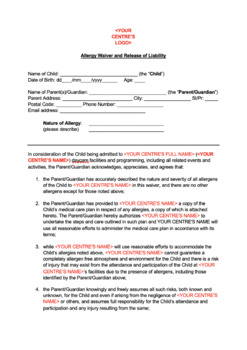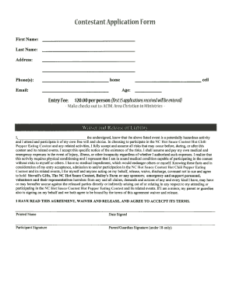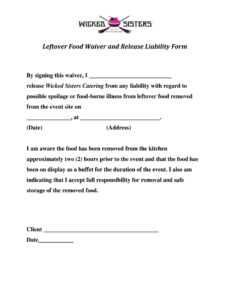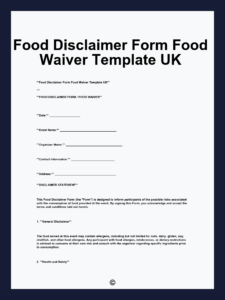Utilizing such documentation offers advantages for both businesses and consumers. For businesses, it provides a measure of legal protection. For individuals with allergies, it facilitates clear communication of their dietary needs, promoting safer food handling practices and reducing the anxiety associated with eating away from home. This proactive approach fosters a safer and more inclusive dining experience for everyone.
The following sections will delve into the key components of these crucial documents, offering guidance on their creation and implementation, and highlighting best practices for ensuring their effectiveness in mitigating allergy-related risks.

Key Components of a Food Allergy Acknowledgement Form
Effective allergy documentation requires specific elements to ensure clarity and functionality. These components work together to protect both the consumer and the food service provider.
1. Identification of the Allergic Individual: Clear identification of the individual with allergies is paramount. This typically includes full name and, if applicable, relevant contact information.
2. Specific Allergen Information: A comprehensive list of specific allergens must be clearly stated. This section should allow for detailed descriptions, avoiding generic terms and including specific ingredients, additives, and potential cross-contaminants.
3. Description of Allergic Reaction(s): A detailed description of the individual’s allergic reactions is crucial. This information allows staff to understand the potential severity of a reaction and aids in appropriate response procedures.
4. Acknowledgment of Risk: A statement acknowledging the inherent risks associated with consuming food prepared in a shared environment, despite precautions, is essential. This acknowledges the establishment’s efforts while highlighting the unavoidable limitations in guaranteeing a completely allergen-free environment.
5. Release of Liability: A carefully worded release of liability, acknowledging the customer’s informed decision to consume food despite the risks, can offer the establishment a degree of legal protection. This section should clearly state the limitations of the establishment’s control over potential cross-contamination.
6. Emergency Contact Information: Providing emergency contact information ensures a swift and appropriate response in case of a reaction. This may include the contact details of a designated individual, as well as preferred medical facilities or procedures.
7. Signature and Date: The document should include spaces for the allergic individual (or their guardian) to sign and date, affirming their understanding and agreement to the terms outlined within.
Complete and accurate information, combined with clear language and unambiguous terminology, ensures these documents serve their intended purpose: promoting communication, managing risk, and fostering a safer dining experience for individuals with allergies.
How to Create a Food Allergy Acknowledgement Form
Creating a robust food allergy acknowledgement form requires careful consideration of several key factors. A well-drafted form protects both the establishment and the consumer by clearly outlining responsibilities and expectations.
1. Consult Legal Counsel: Legal expertise is crucial to ensure the form adheres to relevant regulations and provides adequate legal protection. An attorney specializing in liability and food service regulations can offer invaluable guidance.
2. Clearly Define Scope and Purpose: The form’s purpose should be explicitly stated. It should clearly communicate that the document serves to inform the establishment of allergies and acknowledge inherent risks, not guarantee a completely allergen-free environment.
3. Use Precise Language: Ambiguity can lead to misinterpretations and compromise the form’s effectiveness. Precise, unambiguous language, avoiding jargon and technical terms, ensures clarity for all parties.
4. Structure for Clarity: A well-structured document facilitates comprehension and efficient information retrieval. Utilizing clear headings, bullet points, and concise sentences enhances readability and understanding.
5. Accessibility Considerations: The form should be accessible to individuals with varying levels of literacy. Clear fonts, appropriate font sizes, and ample white space enhance readability.
6. Regular Review and Updates: Regulations and best practices evolve. Regularly reviewing and updating the form ensures its continued relevance and effectiveness.
7. Implement Clear Procedures: Establish clear procedures for staff on how to handle completed forms, ensuring proper communication and implementation of necessary precautions in the kitchen and service areas.
A comprehensive, legally sound, and clearly communicated acknowledgement form, coupled with robust internal procedures, strengthens risk management strategies and fosters a safer environment for individuals with food allergies.
Careful consideration of documentation designed to address food allergies is paramount for both food service providers and individuals with allergies. Understanding the components, creation process, and implementation of these documents is crucial for managing risk and ensuring clear communication. Such forms offer a framework for outlining specific allergens, potential reactions, and the shared responsibility in navigating the complexities of food allergies within a food service setting. This approach emphasizes proactive communication and informed decision-making as critical elements of a safer dining experience.
Prioritizing these measures promotes a more inclusive and informed environment for those with dietary restrictions, while simultaneously protecting establishments from potential liability. Further exploration of resources and best practices within the food allergy community will continue to refine and improve strategies for mitigating risks and fostering positive dining experiences for all.



